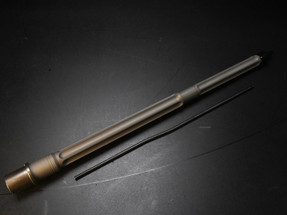Posted by WADE C. on May 2nd 2025
SELECTING THE CORRECT BARREL FOR YOUR AR-15 PART 3
SELECTING THE CORRECT BARREL FOR YOUR AR-15 — PART 3: BARREL LENGTH & GAS SYSTEMS
If you’ve followed along with Part 1 (Barrel Materials) and Part 2 (Cartridge Selection), you’re already making smarter decisions than most AR builders. Now let’s move to the next critical factor: barrel length and gas system configuration.
These two elements work hand-in-hand to determine how your rifle cycles, recoils, balances, and performs. Matching the right gas system to the right barrel length (and cartridge) is essential—not just for function, but for longevity and shootability.
Gas System Basics
Your AR-15 operates by redirecting a small amount of gas from the fired cartridge back through the gas block and into the bolt carrier group to cycle the weapon. The distance between the chamber and the gas port determines the gas system length, which affects how much pressure and dwell time is available to operate the action.
Here’s a basic breakdown:
-
Pistol Length (~4") — Used in barrels up to 10.5", especially for 300 BLK or 5.56 pistols. High gas pressure and fast cycling.
-
Carbine Length (~7") — Common on 10.3–16" barrels. Short dwell time; can be snappy.
-
Mid-Length (~9") — Ideal for 14.5–18" barrels. Smoother recoil and reliable cycling.
-
Rifle Length (~12") — Typically used with 16–20" barrels. Offers the softest recoil impulse.
-
Rifle +1 / +2 — Extended gas systems used in precision-oriented builds, especially with 18–20" barrels.
There are always exceptions based on tuning, suppressor use, and cartridge—but these guidelines cover 90% of builds.
Barrel Length: What You Gain & What You Lose
Longer barrels offer:
-
Higher velocity (especially important with small, fast projectiles)
-
Reduced flash
-
Increased dwell time
Shorter barrels offer:
-
Lighter weight
-
Better handling (especially in tight environments)
-
Often more gas pressure at the port, requiring tuning
Matching your barrel length and gas system is about finding that sweet spot of performance vs. reliability. For example:
-
A 16" barrel with a mid-length gas is a go-to general-purpose setup.
-
An 18" SPR-style barrel with rifle or rifle +1 gas gives you a very soft-shooting DMR setup.
-
A 10.3–11.5" carbine gas barrel is a proven tactical choice—but needs tuning with suppressors.
Cartridge Considerations: Why It Matters
While these are general rules of thumb, newer cartridges like the ARC family (6 ARC / 22 ARC) often require more individualized gas and barrel pairings.
For example, if your goal is to only shoot lighter grain projectiles, like Ally Munitions’ 65gr Coyotero V-MAX, it may be more advantageous to run a 16" barrel with a mid-length gas system. This better matches pressure curves and cycling for that setup.
That’s not to say you can’t take an 18" rifle +1 ARC barrel and run light bullets through it with a traditional baffled suppressor—you can. But the ARC cartridges have changed the traditional design assumptions held by most 5.56-based manufacturers, and we’ll dive deeper into that in a future installment.
What’s Next?
In Part 4, we’ll dive into barrel profiles and contours—how the shape of your barrel affects heat, weight, harmonics, and handling. From pencil barrels to heavy SPR contours, we’ll cut through the marketing and tell you what actually matters.
This is where your rifle’s character is forged. Stay tuned.

